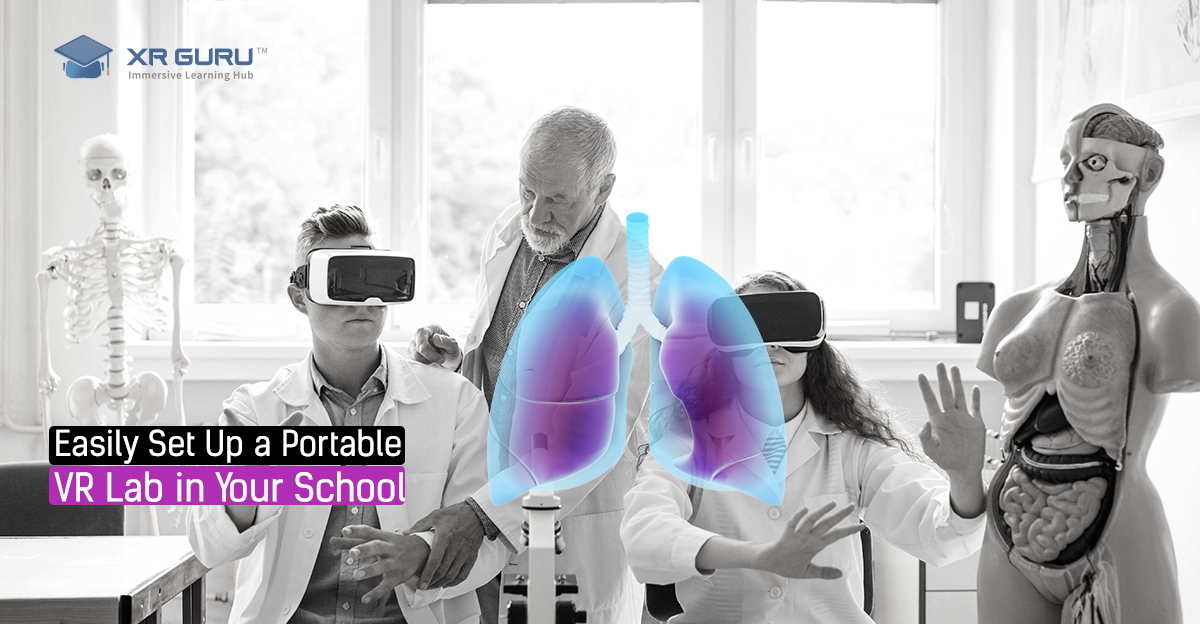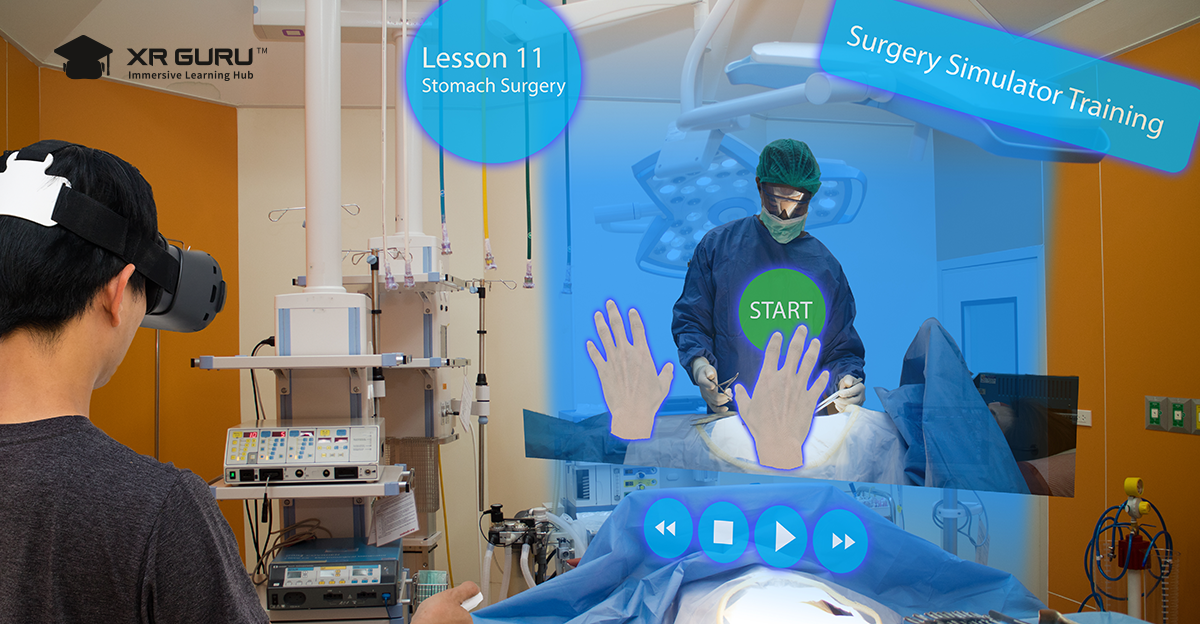
You may wonder, "If labs are expensive, do we need them?" or
"Are there any affordable, feasible alternatives?"
Adopting cutting-edge technologies like Virtual Reality (VR) in education has the potential to transform the way we teach and learn by offering a practical hands-on learning approach. Many institutions have begun to give serious consideration to the idea of using VR to set up virtual reality labs in schools to deliver practical education.
So, why miss out on endless possibilities with VR when others are gearing up to incorporate VR in education to offer a hands-on learning experience?
On January 13, 2022, XR Guru is conducting a webinar titled "Easily Set Up a Portable VR Lab in Your School" to discuss how schools can use virtual reality (VR) technology to set up virtual labs.
Join us to get insights on virtual reality labs!
Here is a recap of this blog.
- What Is Virtual Reality?
- The Current State of Virtual Reality in Education
- What Is a Virtual Reality Lab?
- What Is the Difference Between Virtual & Physical Labs?
- Factors to Consider While Setting Up a Virtual Reality Lab
- What Benefits Does VR Labs Offer for Students & Institutions?
- Be a Part of the VR Educational Revolution
What is Virtual Reality?
Before we dig into the finer details of setting up VR labs, it is essential to understand the basics of virtual reality.
Virtual reality technology creates a computer-generated, interactive 3D simulated environment that captivates the users. Unlike traditional user interfaces where users view information from a screen, VR users are immersed in a life-like environment and can interact with the 3D elements in the virtual world.
In other words, virtual reality is like a magic trick that tricks you into believing you are somewhere you are physically not present.
The Current State of Virtual Reality in Education
You may wonder, is this the correct time for VR-based education?
Don't you feel it is time we do something to improve the learning process?
Utilizing virtual reality for students can dramatically improve the knowledge transfer process by bringing interactive 3D models, images, and simulations into play.
With reports projecting the investment in virtual reality in the education market to grow from $656.6 million in 2018 to 13,098.2 million by 2026, exhibiting a remarkable Compound Annual Growth Rate (CAGR) of 42.9%, it is obvious many institutions are starting to realize the potential of VR in education.
 |
| (Source: Fortune Business Insights) |
Are you excited about the potential of virtual reality in education? Want to know more? Join our webinar session to learn how to use VR in schools to create portable VR labs.
What Is a Virtual Reality Lab?
Virtual labs are learning tools aimed at developing students' laboratory skills.
VR labs present an immersive, secure simulated learning environment to perform experiments and enable learners to get hands-on learning experiences. Students can explore and participate in simulated lab exercises in a safe environment. VR labs also present an opportunity to access advanced lab equipment that might not otherwise be available. Unlike physical labs, VR labs allow learners to carry out experiments without any safety, time, or space constraints.
What Is the Difference Between Virtual & Physical Labs?
Constructing physical labs can be expensive and requires a large amount of space. Since most schools operate on a limited budget, affording advanced, state-of-the-art lab equipment can be a major challenge. In addition, many schools do not have the physical space required to construct big labs.
Further, there are chances of mistakes and mishaps occurring while doing high-risk experiments. For example, there can be fire accidents in chemistry labs if the elements are not handled properly. However, incorporating VR in education eliminates a lot of the risk involved in a conventional lab setting. Also, virtual reality labs are very cost-effective.
Factors to Consider While Setting Up a Virtual Reality Lab
Now that we have covered some basics of VR labs, you may be wondering, how do I go about setting up a VR lab?
Well, here are a few things you should consider before choosing a VR system for your science lab.
- Budget: Finding a system that fits your budget is paramount when setting up a VR lab.
- Customizability: A good VR platform should be upgradeable and scalable to incorporate the latest tech features and your varying educational requirements.
- Usage: What do you wish to accomplish with the VR lab? Different use cases may require additional hardware equipment.
- Quality: Choosing a VR platform capable of delivering high-level visuals and swift responsiveness is vital. A sub-par VR system leads to visual lagging and haziness, which can cause motion sickness and loss of interest.
What Benefits Do VR Labs Offer to Students & Institutions?
I can hear you asking, "How can virtual reality labs be beneficial?"
"Is it really more advantageous than a physical lab setup?"
There are several advantages of using VR in schools to provide a practical learning experience, and here are some benefits provided by VR labs.
1. Best-in-Class Equipment
If you are wondering, how can I afford cutting-edge lab equipment with a low budget? Do not worry; VR is here to save the day.
Virtual reality labs offer educational institutions easy access to top-notch lab equipment. You no longer need to settle for low-end or outdated equipment. Your students can compete with their counterparts with VR-powered labs to learn advanced concepts.
2. Safe Training Environment
A traditional laboratory setup is replete with risks. The worry of somebody getting injured or causing damage to expensive equipment is ever-present. However, a virtual lab eliminates many of these risks and presents a safe environment for students to hone their skills. A secure environment enables the students to learn from their mistakes without worrying about the real-life consequences. In a simulated environment, the students feel safe and are motivated to practice as often as necessary until they perfect their craft.
For example, medical students can practice surgery and learn to operate using VR without harming a real-life patient.

3. Visual Aid for Learners
Would you rather teach by reading from a book or using VR simulations, 360° VR videos? Using VR sounds effortless and more fun, right?
Virtual labs make it easier for teachers to explain abstract concepts with interactive visual 3D models. Virtual reality in education brings theoretical concepts to life through stunning visuals and immersive simulations. These visuals make it easier for students to comprehend complex topics.
4. Engages Students
Listening to lectures and watching videos or presentations can eventually become boring for students. Virtual reality learning captures the attention of learners and sparks their curiosity by allowing them to test complex experiments easily in an online virtual setup. With VR in schools, teachers can enhance student engagement levels through immersive lessons.
Let's be honest, why should students read from books when they can watch, feel, and be a part of what they learn?
A study shows in active learning methods like VR learning, students learn and engage better compared to traditional textbook-style learning.
 |
| (Source) |
5. Cost-Effective
Besides accessibility to world-class lab equipment, adopting virtual reality eliminates the cost of building multiple labs and buying/maintaining expensive apparatus. With VR labs, VR headsets and content are all you need to experience a fully immersive laboratory experience. VR learning helps schools provide a better learning environment at a fraction of the cost.
6. Better Collaboration
Working as a team and cooperating with teammates is essential in a laboratory environment. Most scientific research requires people from different fields to collaborate and work together. With the help of VR in education and features like VR avatars, connecting with people all over the world becomes relatively easy. With virtual meetings and conferences, connecting with people is easier than ever.
Are you excited about the benefits of VR labs? Join our webinar session to learn more about using virtual reality labs.
Be a Part of the VR Educational Revolution
Using virtual reality in classrooms for a practical learning experience offers many advantages. The above-stated benefits just scratch the surface of the immense potential of VR in education. Virtual reality in schools can overcome the limitations of a traditional laboratory setup and bring much-needed practical elements into play, making education hands-on, interactive, and enjoyable.
Given the multitude of recent technological advancements, VR hardware has and continues to become far more affordable, making it more accessible and widespread. Therefore, it is safe to assume VR will become a necessity in the near future, and it will play a major role in transforming the learning experience.
So, what are you waiting for? Jump on the VR bandwagon today!
Do you wish to incorporate virtual reality in your school? XR Guru is an immersive learning hub that can fulfill all your VR learning requirements. With exciting features like curated course content, an ever-growing content library, and tools to increase student engagement, XR Guru is your best option to deliver an immersive, hands-on learning experience. Contact us for a free consultation on all your virtual reality educational needs.
Join Us for Our Next Webinar
Title: Easily Set Up a Portable VR Lab in Your School
A new way to teach science in the new year!
Education is evolving swiftly, and it is no longer solely dependent on learning information by reading a textbook. Many schools are beginning to integrate augmented reality (AR) and virtual reality (VR) headsets into classrooms, especially for science.
Join our live webinar on January 13, 2022, to learn more about integrating immersive technology into your science classes (biology, chemistry, physics). View science content on Oculus VR, iPad, Android tablets, and Chromebooks.
If you cannot attend, register anyway and we will send you the recording.
Host: Doug Smith
When and Where:
11 a.m. (EST), Thursday, January 13, 2022.
Duration: 25 minutes.
Join using the Zoom link (sent after registration)
Goal: To help educators create immersive virtual labs in schools and illustrate the benefits of a VR-based learning approach.
Who should join this webinar:
- Principals (HS and MS),
- Physics Educators,
- Biology Educators,
- Chemistry Educators,
- Administrators, and
- those intending to embrace immersive technologies in their schools.
Highlights of the Webinar:
- Learn the research on VR/AR learning in education
- View samples of the science content
- Learn about accessing the School Admin/Teacher Portal
- Register for free full access to experience all modules
Outcome: Attending this webinar can help you understand how adopting Virtual Reality technology improves student engagement.